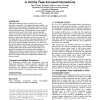Free Online Productivity Tools
i2Speak
i2Symbol
i2OCR
iTex2Img
iWeb2Print
iWeb2Shot
i2Type
iPdf2Split
iPdf2Merge
i2Bopomofo
i2Arabic
i2Style
i2Image
i2PDF
iLatex2Rtf
Sci2ools
GROUP
2003
ACM
2003
ACM
Studying the effect of similarity in online task-focused interactions
Although the Internet provides powerful tools for social interactions, many tasks—for example, information-seeking—are undertaken as solitary activities. Information seekers are unaware of the invisible crowd traveling in parallel to their course through the information landscape. Social navigation systems attempt to make the invisible crowd visible, while social recommender systems try to introduce people directly. However, it is not clear whether users desire or will respond to social cues indicating the presence of other people when they are focused on a task. To investigate this issue, we created an online game-playing task and paired subjects to perform the task based on their responses to a short survey about demographics and interests. We studied how these factors influence task outcomes, the interaction process, and attitudes towards one’s partner. We found that demographic similarity affected how people interact with each other, even though this information was not expl...
| Added | 05 Jul 2010 |
| Updated | 05 Jul 2010 |
| Type | Conference |
| Year | 2003 |
| Where | GROUP |
| Authors | Dan Cosley, Pamela J. Ludford, Loren G. Terveen |
Comments (0)

